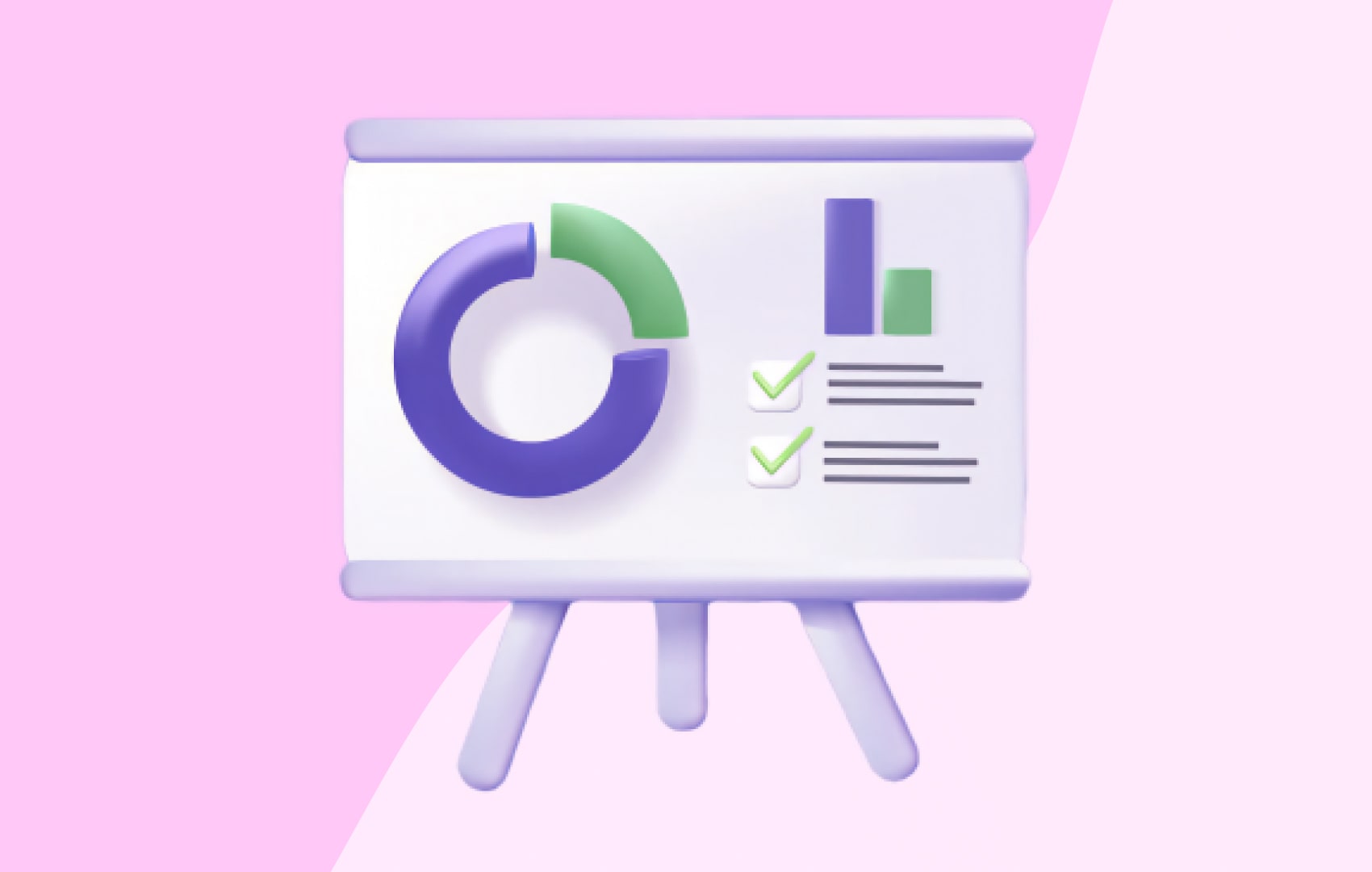Inbound vs Outbound Marketing: All You Need to Know About Leadgeneration Types

Marketing is essentially a bridge between businesses and their customers. Thus, it plays a pivotal role in defining how effective this connection is and how you can improve it. Growth paths businesses choose differ a lot. Because of this difference, the choice is often unclear.
In this article, we will set the record straight regarding the choice of inbound vs outbound marketing for your venture. We will outline the definition of each, their strengths and weaknesses, along with the most prominent tactics. Later, when the picture is clear, we will compare both and let you figure out which one is a match for your business.
As promised, let’s start with the definition.
Understanding inbound marketing
In the business development world, the inbound marketing concept is popular. In fact, it is because the inbound approach takes advantage of connectivity and information flow. Unlike traditional strategies, inbound marketing focuses on drawing potential customers in through valuable content, engagement, and solutions tailored to their needs.
Inbound marketing is centered around earning the attention and trust of your target audience. In some cases, such an approach is proven to be far more effective than merely pushing messages outward, hoping someone will like them.
So, at the core of inbound marketing lies the philosophy of creating, sharing, and managing helpful, relevant, and informative content that people will find useful. This approach fosters genuine connections and positions your brand as a reliable source of expertise and solutions.
In fact, such an approach has become a winning decision for many businesses that have shifted from traditional outbound practices. So, what benefits can inbound marketing bring to your business? Let’s find out.
Benefits of inbound marketing
Basically, there are many benefits of this approach. Here are a few major ones.
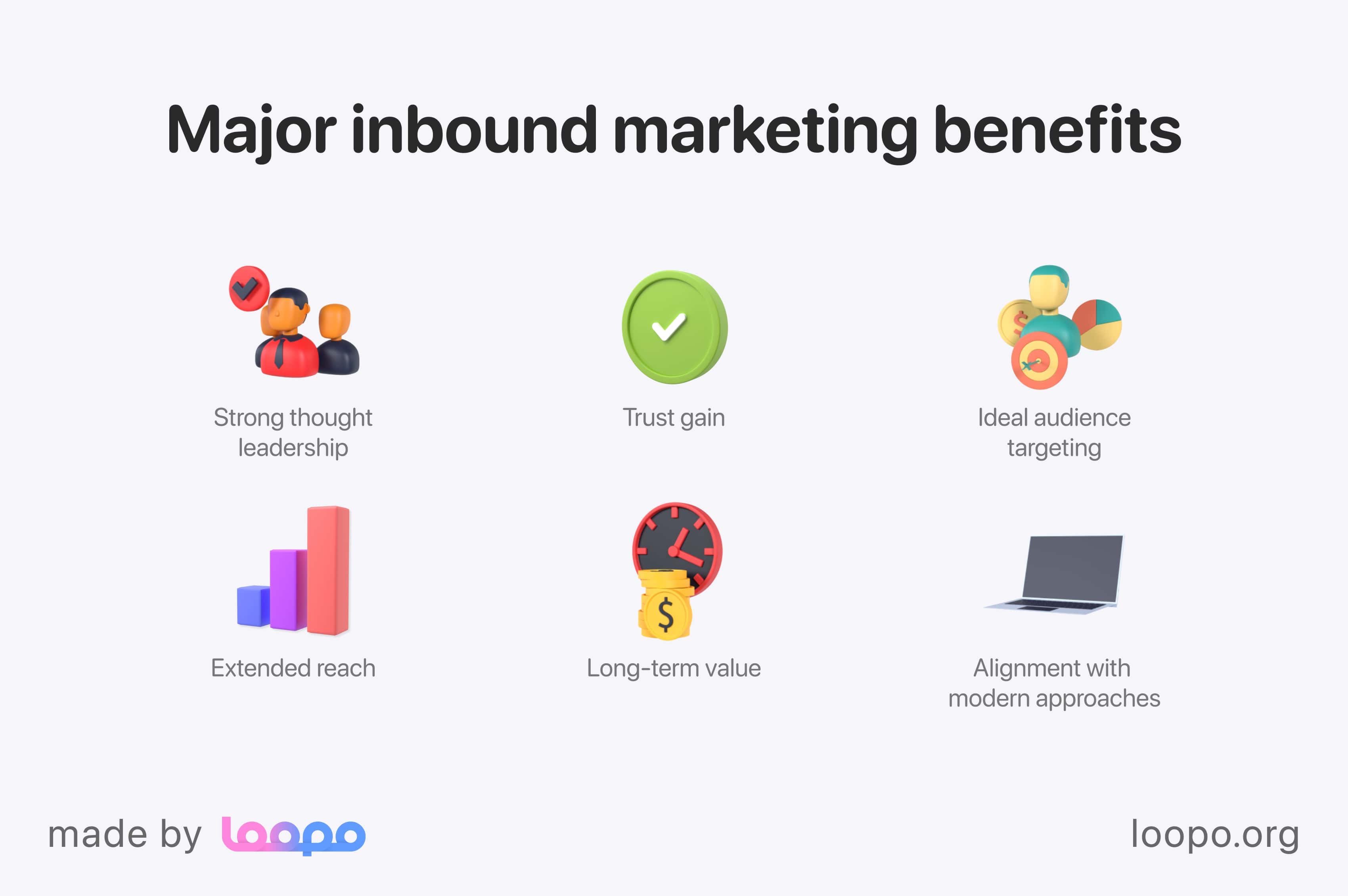
Strong thought leadership
Logically speaking, inbound marketing advocates providing useful and relevant content. It aims to help people, address their problems, and provide solutions. Consequently, the more value you provide, the stronger thought leadership you acquire. In your content, you can propel innovative ideas and bring new perspectives. Moreover, by making regular efforts in content marketing, you can establish yourself as a reliable speaker who understands the industry's challenges and offers solutions. This recognition elevates your company's status within the niche.
Trust gain
Simply put, trust is very interconnected with the thought leadership we discussed. In fact, it is the cornerstone of relationships between customers and businesses. Regarding inbound marketing, it can bring a lot of trust from your users thanks to the emphasis it puts on education and value.
Ideal audience targeting
As mentioned, the inbound approach focuses on providing value through the content. Thus, one of this approach’s strengths is its ability to target your ideal audience precisely. When you create tailored content, you can easily attract prospects who are genuinely interested in what you have to offer. This focused engagement generates higher-quality leads that are more likely to convert into loyal customers.
Extended reach
Unlike the outbound approach, inbound marketing takes advantage of what the digital world has to offer. It effectively uses social media, search engines, forums, and other platforms to acquire a far-reaching impact. What does it bring you? A lot, in fact. It boosts your brand's visibility, opens the door to international markets, and allows you to scale your business extremely fast.
Long-term value
Even though you need to invest in creating inbound-oriented content upfront, it can bring a lot of value in a long-term perspective. Simply put, valuable content oftentimes remains evergreen, meaning that it doesn’t get worse with time and is always relevant. This sustained value ensures that your marketing efforts continue to yield returns well into the future.
Alignment with modern approaches
Today’s users are more mindful, careful, and informed when it comes to consuming information. In simple terms, according to GE Capital Retail Bank’s study, more than 80% of shoppers do research before purchasing something online. Inbound marketing resonates with this behavior, as it provides the information and solutions they seek, enhancing the likelihood of them choosing your brand over competitors.
Key inbound marketing tactics
Now that the term is defined and the benefits are clear, let’s shift attention to inbound vs outbound marketing examples. Apparently, there are many approaches, and traditionally, we will list the most potent and popular.
Content marketing
This is an absolute leader, an engine that powers the entire inbound marketing strategy. In the right hands, successful content marketing goes beyond just producing content. It implies creating a potent strategy. This strategy, in turn, outlines everything there is to know about the creation process, planning, distributing, and analyzing the content you create. Here’s a short explanation of those processes.
Inbound marketing tactic | Description |
Content planning | The process of identifying your target audience, understanding their needs, and creating a content calendar that addresses their pain points throughout their buyer's journey. |
High-quality content creation | The process of producing content that not only educates but also engages. This often involves in-depth research, expert interviews, and a focus on providing solutions rather than just information. |
Effective distribution | The process of using various channels like your website, social media, email marketing, and guest posting to get your content in front of your audience. |
Performance analysis | The process of regularly evaluating the performance of your content through metrics like traffic, engagement, and lead conversion. This data-driven approach helps refine your content strategy over time. |
Search engine optimization
To make your content popular and discoverable, SEO is the best tactic you can imagine. Basically, search engine optimization utilizes different tactics to ensure the content ranks higher in search results and that it attracts more visitors to the website. Accordingly, SEO is a go-to tactic to choose. Here are its key elements.
- Keyword research. Keywords stand for specific words and combinations that are popular within a certain topic. Thus, you can saturate your publications with them, and when people search for something using those keywords, they will most likely see your page among the results.
- On-page optimization. This process includes various checks and deep website analysis. In the result, it analyzes whether the content is structured enough, the website loads fast, it is performant, and people have no issues engaging with the content it provides.
- Quality backlinks. To increase the authority of your site, you can build a serious network of backlinks incorporated into your content. Links from solid and authoritative websites within your niche can greatly increase the visibility of your page.
- Content optimization. The content you publish needs regular revisions and updates. Thus, when you keep it up-to-date, it indexes better in search engines and preserves more relevance to users.
Social media
All of today’s social media platforms are great facilitators and game-changers in inbound marketing. Simply put, platforms like LinkedIn, Instagram, Facebook, Reddit, and others provide golden opportunities for companies to connect with their audience. They can share numerous types of content, foster discussions, and even receive live feedback. Here are the cornerstones of a successful tactic that involves social media.
- Smart platform selection. To create an effective strategy in social media, observe the platforms where your target audience is most active and prioritize them.
- Effective content sharing. Do not simply publish walls of text. People enjoy infographics, visuals, reactions, and videos. Consider sharing a mix of your own content, which may include different elements and attract different kinds of people.
- Active interactions. People are used to connecting with others on social media. Thus, make sure you are active too. Keep responding to comments, answer frequently asked questions, and engage in discussions.
- Paid advertising. To promote your content more effectively, paid advertising is a great tool the majority of social media platforms provide. With paid advertising, you can target certain groups of people and their demographics and amplify your content's reach.
Understanding outbound marketing
To start with, outbound marketing is completely the opposite of inbound marketing. In fact, outbound marketing is a starting point in the entire industry, and it has been a tried-and-true approach for decades.
As mentioned earlier, inbound marketing aims to draw prospects in with valuable content. Outbound marketing, in this regard, involves reaching out to potential clients directly. It is rooted in the concept of proactively reaching out to a defined audience to promote products or services. This approach involves initiating contact with potential clients through various channels. Common channels are, for instance, cold calls, emails, advertising, and direct mail. Consequently, the ultimate objective of this approach is to generate interest and create awareness.
Benefits of outbound marketing
Even though outbound vs inbound marketing may look weaker and less thoughtful, it still has lots of benefits as it is still popular these days. So, in the right hands, the outbound approach lets you:
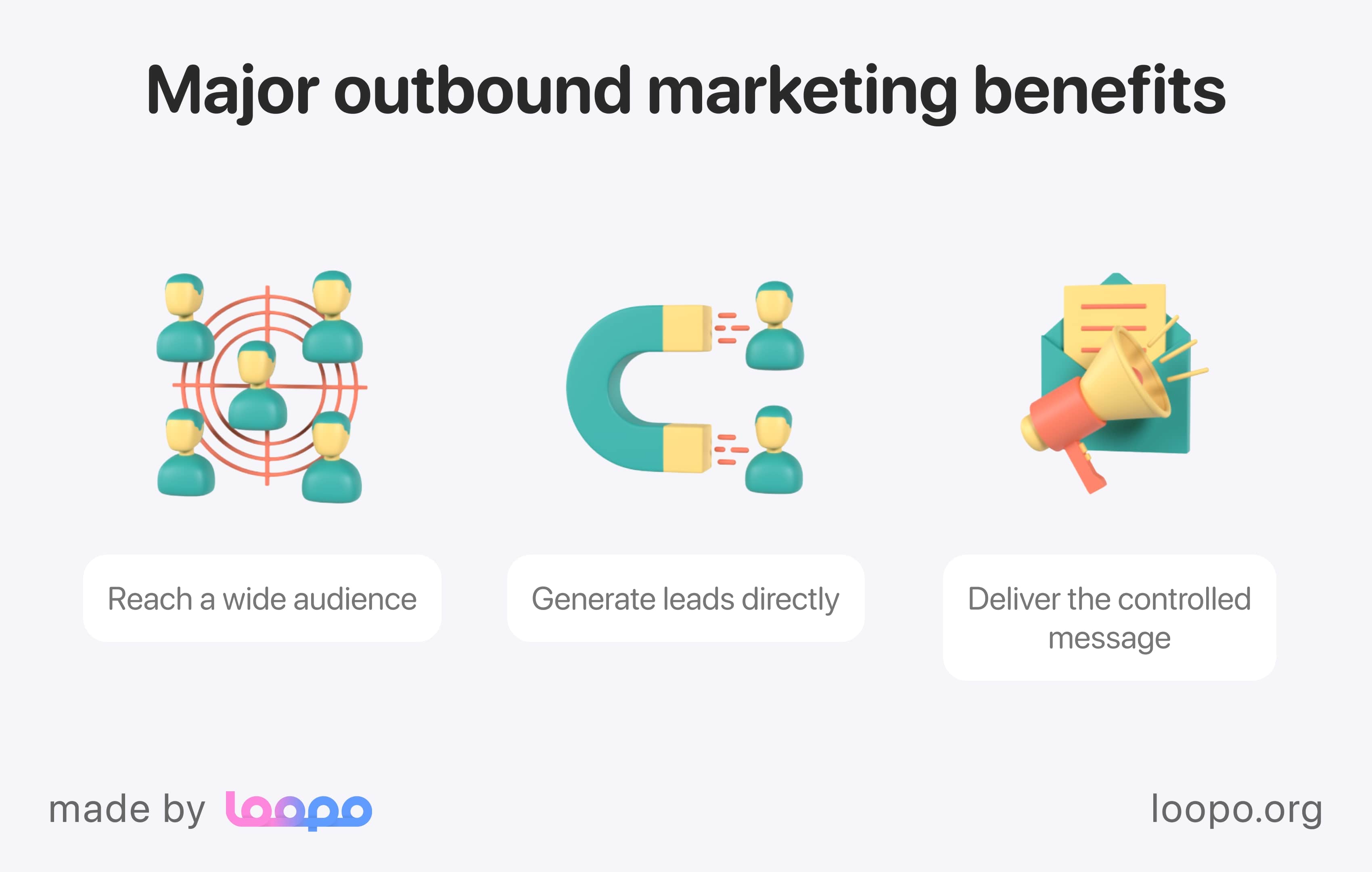
Reach a wide audience
By using simpler channels and creating more massive marketing campaigns, outbound marketing has the potential to cast a wide net, exposing your brand and offerings to a broader audience. This is particularly advantageous when your target market is diverse or when you aim to enter new markets.
Generate leads directly
Outbound strategies are effective for immediate lead generation. Cold calls, for example, can result in direct engagement with decision-makers, potentially accelerating the sales cycle.
Deliver the controlled message
With outbound marketing, you have control over the message and its timing. This allows you to tailor your communication to specific promotions, product launches, or market events.
Key outbound marketing tactics for B2B
With the understanding that outbound marketing is more of an all-encompassing strategy, it becomes evident that it has more tactics than the outbound approach. Moving away from the theory, let’s look at some practical tactics you can use when choosing outbound marketing for your business.
- Cold calling. This tactic is very old and may seem irritating to users, yet it is still effective. It implies contacting people with unsolicited phone calls to promote the product, ask for their opinions, and attract them to use it.
- Cold emailing. This tactic appeared right after the cold calling and is practically the same. The difference is that it implies using users’ emails to send them newsletters, ads, and other materials to promote your product and make them purchase it. Both cold calling and emailing require a solid script that can captivate users’ attention and persuade them that the product is worth their attention.
- Direct mail campaigns. For companies that produce particular products, there’s a way to create direct mail campaigns. Simply put, they imply sending physical marketing materials, such as brochures, catalogs, or promotional items, to targeted prospects. Direct mail can be highly effective when executed with personalization and creativity.
- Pay-per-click (PPC) advertising. To create some noise about the product, outbound tactics also rarely neglect PPC ads. For this, you can use online advertising platforms like Google Ads to set up specific ads that’ll be tailored to different people with similar likings.
- Offline events. This tactic practically disappeared in post-covid times, yet luckily, it is starting to revive. To advertise products or services, companies often participate in industry-specific events. They are created to showcase products and services, network with potential clients, and gather leads.
Comparing inbound and outbound approaches
It can be challenging to choose a suitable approach right away. Both inbound marketing vs outbound marketing are quite different, providing varying solutions and having their own advantages and disadvantages. Accordingly, let’s shift attention to the core differences in outbound marketing vs inbound marketing. Drawing the line between the two can greatly help you make an informed choice and follow the right path.
Cost-effectiveness
Let’s start with prices, as this is the aspect that people care about the most. Both approaches’ budget is formed differently. Here is how.
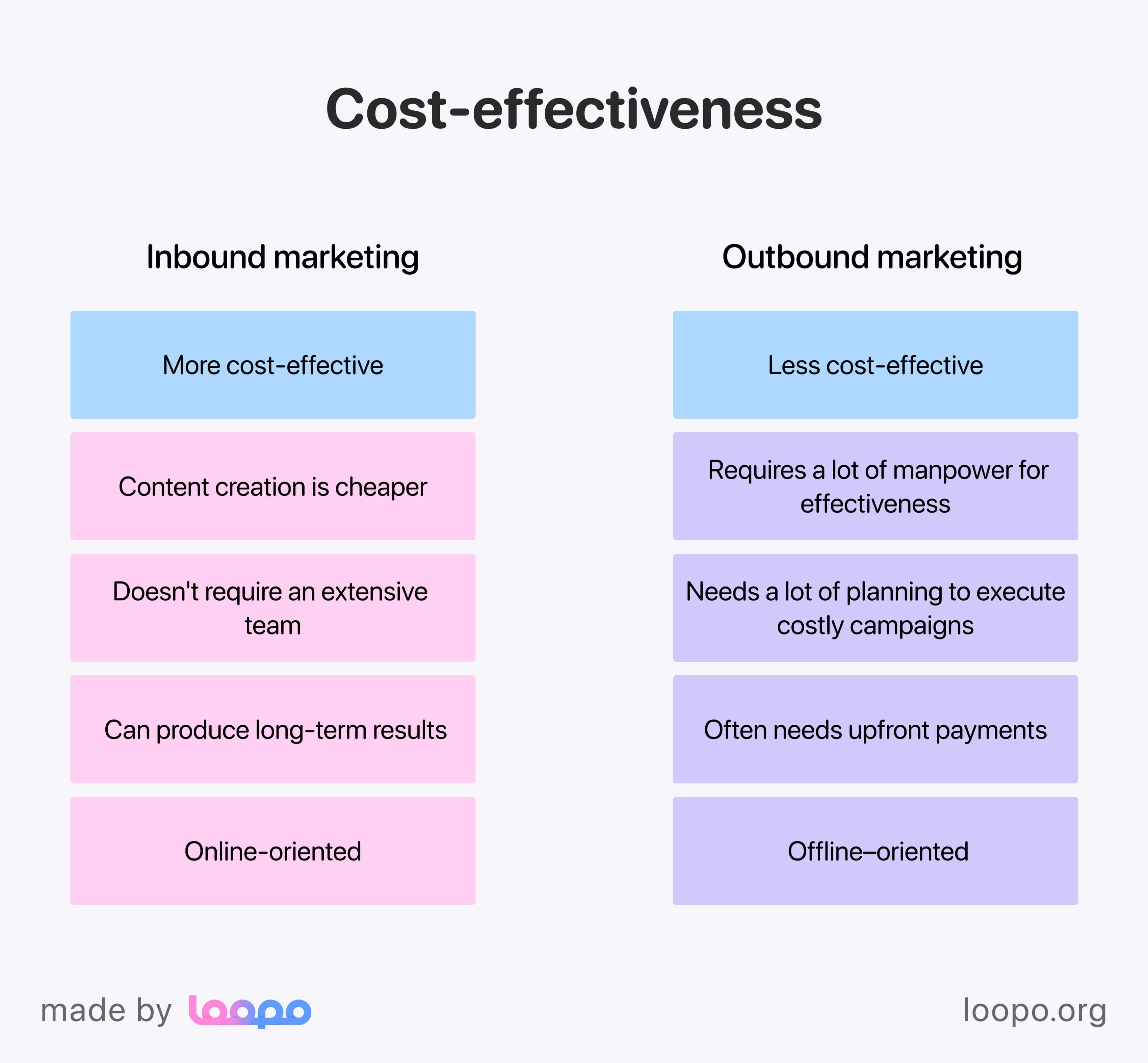
Inbound marketing
Budget-wise, inbound marketing is an absolute winner in this confrontation, as it is often celebrated for its cost-effectiveness. As we already know, content creation forms its core. Apart from the content, there’s SEO, social media engagement, and other things that can be significantly more budget-friendly than outbound methods.
Generally speaking, there are lots of types of content that can be done by one person singlehandedly. Alternatively, a creative team of 3-5 people consisting of an SEO specialist, a copywriter, and an SMM manager can do all the work perfectly. Moreover, it also benefits from the compounding effect, where evergreen content continues to attract leads over time, further enhancing its cost-effectiveness.
Outbound marketing
Basically, outbound marketing is effective. However, with great effectiveness come big price tags. Outbound marketing has a great potential to generate an enormous amount of leads and interest in your enterprise, but it tends to be costlier.
The main reason for higher prices is that outbound marketing requires way more manpower for its campaigns. For instance, initiatives like cold calling and emailing require lots of employees who will do it regularly. Alternatively, large-scale mail campaigns require solid upfront investments to get started. After all, the cost-per-lead is significantly higher, but so are lead generation rates.
Lead quality and conversion rates
These are not the aspects you think of first. Nonetheless, they are extremely important as they directly influence the quality and proficiency of your marketing campaigns by using either an inbound or outbound approach. So, regarding lead quality and the state of conversion rates, inbound marketing focuses on the overall quality of these aspects, while the outbound approach prefers volume. Here are important takeaways to support this thought.
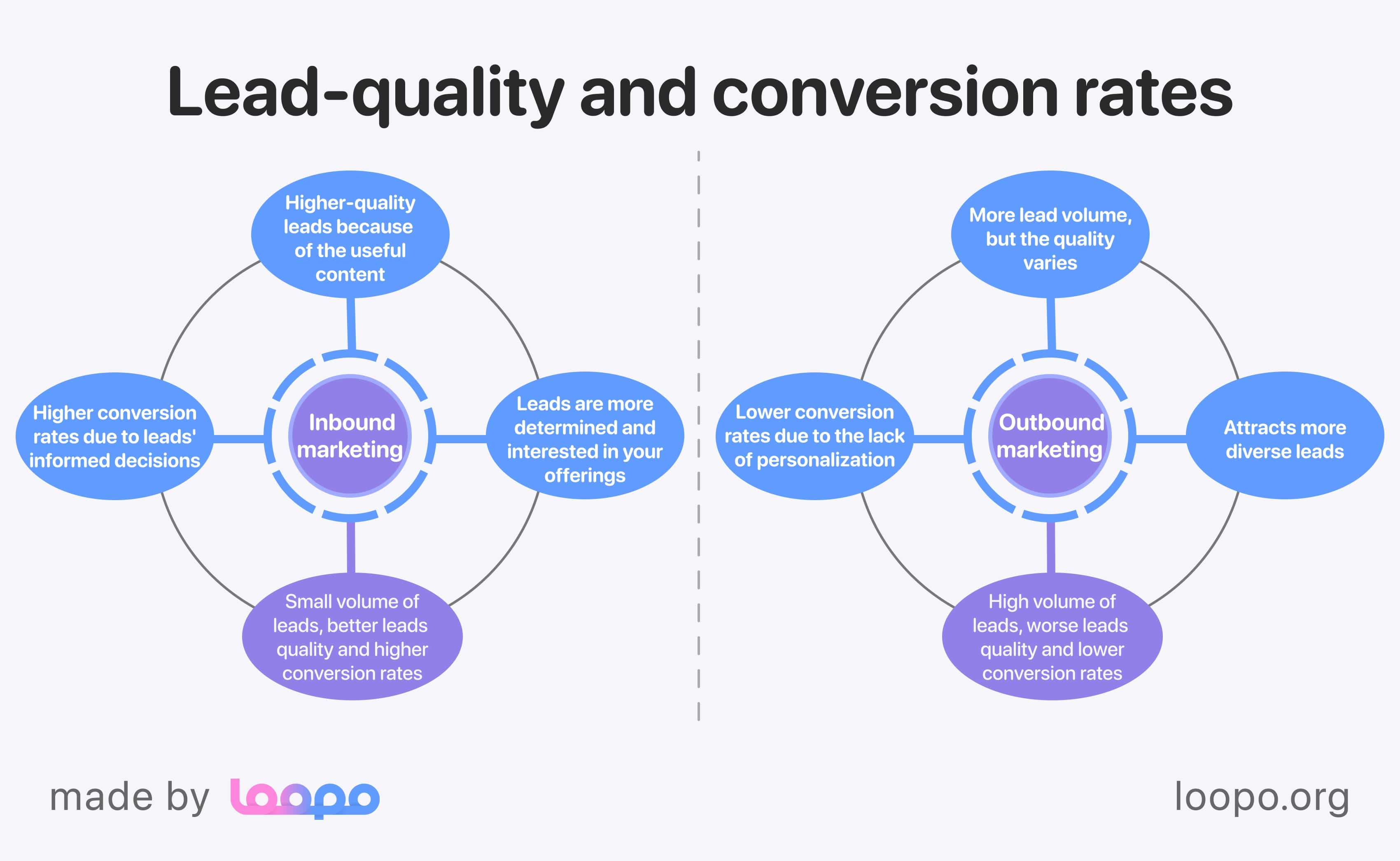
Inbound marketing
With a main focus on educational and informative content, inbound marketing tends to generate higher-quality leads. Simply put, the prospects you turned into leads were interested in your content; they found it useful, interesting, or educational. When they engage with your content voluntarily, they are typically more interested in your offerings. Moreover, they are then more determined regarding the product or service you offer.
With such effective lead generation, conversion rates grow as well. Simply put, people take time and effort to study your offering and make a more informed decision. Thus, if your product or service is worthy, your conversion rates can skyrocket!
Outbound marketing
In the comparison of outbound marketing vs inbound, outbound marketing may generate a much larger volume of leads, but the quality can vary. The practices outbound marketing utilizes imply attracting all sorts of people without differentiating them into groups by interests, hobbies, or occupations. Thus, some leads may be less qualified, as they might not have actively sought out your products or services.
As a consequence of poor lead quality, conversion rates can be lower. However, outbound marketing uses direct outreach, which can still yield results and substantial sales opportunities just because of the massiveness of the campaigns it organizes.
Relationship building and customer retention
Apart from pricing concerns and quality, the relationship your business builds with customers is of utmost importance. Hence, it is important to preserve their loyalty and keep them engaged and interested. Regarding the comparison of the two approaches, inbound marketing vs outbound have different relationship-building mechanisms.
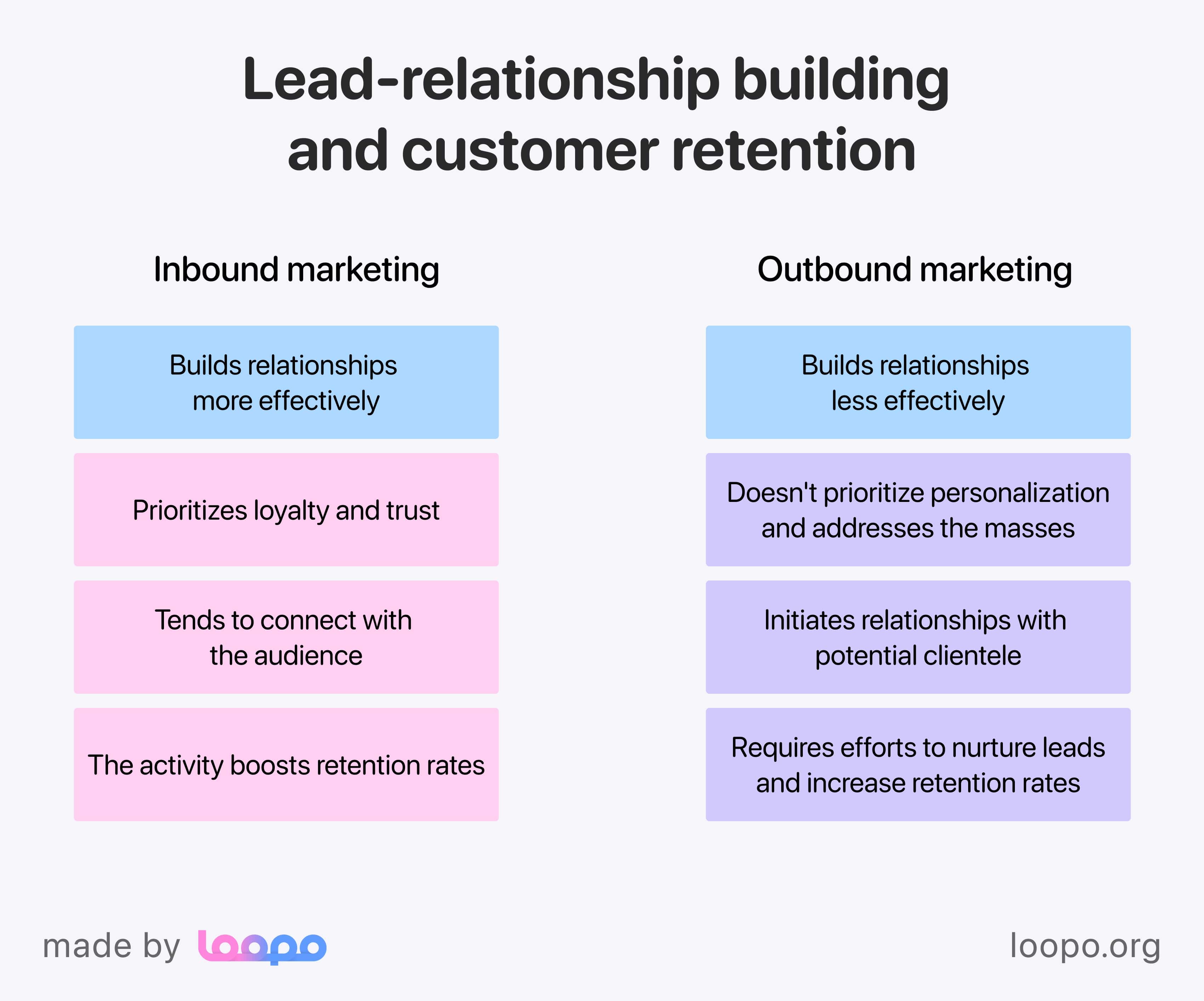
Inbound marketing
Considering that the content inbound marketing produces is one of a few touchpoints with the clientele, it excels at building relationships and fostering customer loyalty. Simply put, with valuable content and regular engagement with prospects on their terms, you can create a foundation of trust that can lead to long-term relationships.
Additionally, companies that focus their efforts on building trust and authority and acquiring the loyalty of their customers tend to connect with people. For example, you can often see how even big businesses actively engage in discussions, ask for opinions, and focus on users’ feedback.
Accordingly, all those aspects are highly beneficial, and they boost retention rates. When people see that the product is not only worthy but the company also makes efforts to please the audience, the percentage of users who keep using the product only grows.
Outbound marketing
Considering outbound marketing uses more raw methods and arrays of users, it rarely focuses on personalization and relationship-building. Obviously, outbound marketing emphasizes the beginning of relationships and initiates them, in fact. Consequently, the nature of direct outreach can sometimes create a transactional rather than a relational dynamic.
As a result, when choosing outbound marketing, you will need to put a lot of effort into further lead nurturing. Hence, retention rates may be lower at the beginning, but as relationship-building efforts progress, so will retention rates.
Adapting to modern buyer behavior
As the digital landscape changes, so do buyers' behaviors. Accordingly, both inbound and outbound approaches have different methods of dealing with those changes.
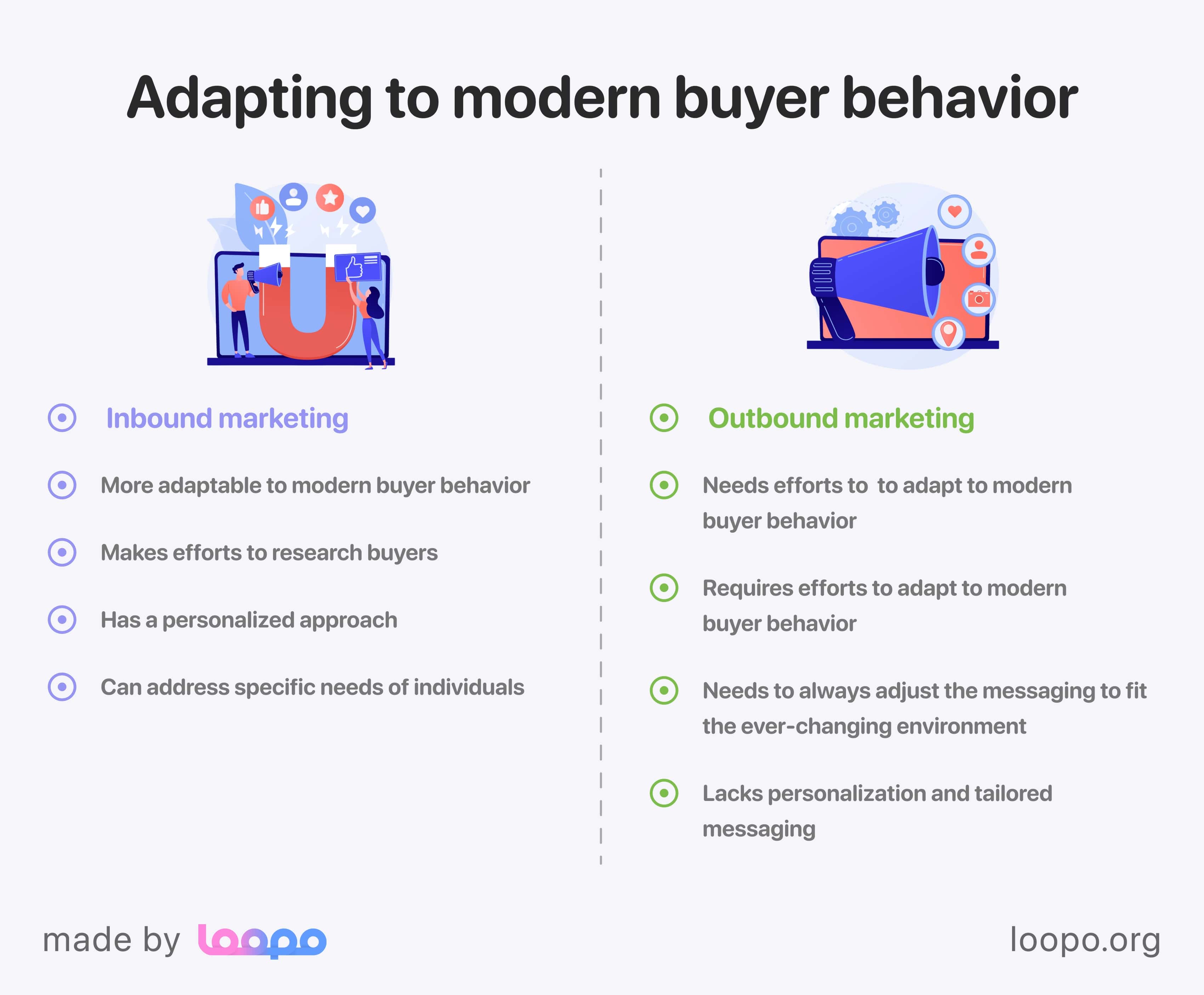
Inbound marketing
It aligns seamlessly with modern buyer behavior. It caters to the self-directed research process of buyers who prefer to explore solutions independently before engaging with sales representatives. Thanks to the personalized approach it advocates, it can greatly read buyer behavior and address specific needs.
Outbound marketing
As its content is more raw and usually targets a wide pool of buyers, it may need to adapt to modern buyer behavior. It's crucial to be mindful of interrupting potential customers and ensure that your messaging is relevant and timely to capture their attention effectively.
In summary, the choice between inbound marketing vs outbound should be guided by your specific goals, target audience, and resources. Inbound marketing tends to be more cost-effective, excels at relationship building, and aligns with modern buyer behavior.
On the other hand, outbound marketing can deliver quick results and may be appropriate for certain industries or when immediate lead generation is crucial. Evaluating both approaches within the context of your B2B marketing strategy can help you strike the right balance and achieve the best results.
Crafting a balanced approach
Needless to say, balance in all things matters a lot. In fact, considering how different inbound marketing vs outbound marketing approaches are, you should think about adopting a balanced approach that leverages the strengths of both strategies.
Let’s dive deeper into this aspect and talk about how to find a balance and how to choose the best aspects of each approach.
The hybrid strategy
The realization that inbound and outbound marketing need not be mutually exclusive has given rise to the hybrid strategy. This approach involves integrating elements of both approaches to maximize their collective impact. By doing so, businesses can create a well-rounded marketing plan that harnesses the strengths of each method.
Let’s look at some examples.
1. Email marketing (inbound) + offline events (outbound)
With this strategy’s synergy, your hybrid strategy can be very effective both online and offline. In this regard, email marketing is used to build excitement and anticipation for your offline events. It often includes valuable content related to the event's topic or speakers as well as related content people might want to explore.
2. SEO and content marketing (inbound) + warm outreach (outbound)
This synergy is particularly helpful if you are planning to create a strong community around your brand, along with personalized connection. Firstly, SEO and content marketing part do their best to create superior quality content and make it visible. Then, with outbound’s warm outreach method, qualify leads based on their engagement with your content and target the most promising ones. Later, your follow-up actions matter a lot. If initial outreach results in interest but not immediate conversion, use content marketing to nurture leads. Share more in-depth content, case studies, or testimonials to build trust over time.
3. Influence marketing (inbound) + look-a-like paid ads (outbound)
At the core of this synergy lies the idea of creating authentic and engaging content through partnerships with influencers and nurturing the audience with paid ads. Essentially, you will need to partner with the right people to attract the right audience. Then, use look-alike audience segments for your paid ad campaigns based on the characteristics of your influencer's followers. As a result, this approach targets an audience with similar interests and demographics.
Identifying your audience
The foundation of any successful marketing strategy, whether inbound, outbound, or hybrid, is a deep understanding of your target audience. Identifying your ideal customers and their pain points is essential for creating effective messaging and marketing tactics.
Regarding inbound and outbound marketing, they have different approaches to identifying the audience. Speaking of which, let’s outline the major differences.
Aspect | Inbound marketing | Outbound marketing |
Audience segmentation | Focuses on creating detailed buyer personas. It advocates creating very tailored that fixes specific pain points. It emphasizes the preferences of different segments within your audience because its ultimate goal is to build trust. | With this approach, the entire audience identification process is about creating and compiling lists of potential prospects based on simple criteria like industry, job title, and location. |
Messaging alignment | Emphasizes empathetic and trust-building content. Additionally, it is always focused on providing help, solutions, guidance, etc. | Focuses on concise, compelling value propositions. Messaging is rarely tailored. Instead, it is customized to resonate with user segments, aiming for quick attention and action. |
Goal alignment | Often targets lead generation and brand awareness with content engagement metrics. | Oriented toward immediate lead generation and sales conversion. The majority of goals are related to response rates, appointments set, or campaign success. |
Feedback loops | Take advantage of analytics to refine strategies based on content performance. | Gains insights from direct sales interactions, calls, or emails. |
Finding balance depending on your business model
Not all businesses are created equal, and as such, not all marketing strategies should be uniform. Your specific business model, industry, and niche play a significant role in determining which tactics are most effective. To create a balanced marketing approach, it's vital to align your strategies with your business model. Here's how to do it effectively.
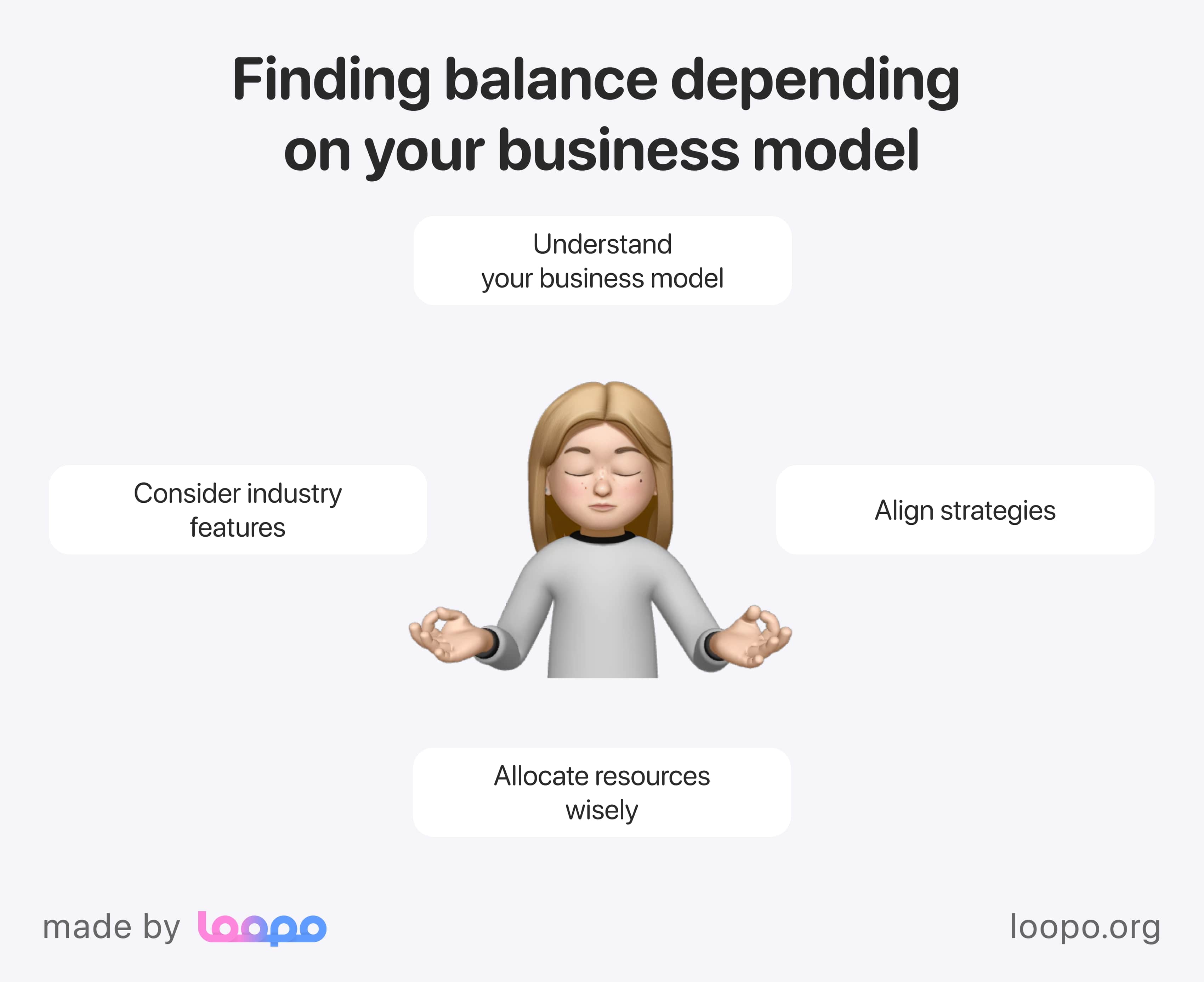
1. Understand your business model
In this regard, there are three main cornerstones you can rely on.
First of all, determine whether your business primarily serves other businesses (B2B) or individual consumers (B2C). This distinction significantly influences your target audience, sales cycles, and marketing tactics.
Secondly, consider whether you offer products, services, or a combination of both. The nature of what you provide can affect how you market and sell.
Finally, analyze the typical length and complexity of your sales cycle. Some businesses have long, relationship-driven sales cycles, while others operate with shorter, transactional cycles.
2. Align strategies
If your business model involves longer sales cycles and relationship-building, inbound marketing can be particularly effective. Educational content and thought leadership can help nurture leads over time, eventually leading to conversions.
For businesses with shorter sales cycles or where immediate lead generation is crucial, outbound tactics like cold calling, targeted email campaigns, and pay-per-click advertising may be more fitting. Outbound methods can help quickly identify and engage potential customers.
3. Allocate resources wisely
Assess your resources, including budget, team capabilities, and time. Ensure your chosen strategies align with your available resources. This might involve adjusting your marketing mix to balance costs and effectiveness.
4. Consider industry features
Depending on your industry, certain strategies may be more effective. For example, the healthcare industry might rely more on educational content (inbound), while the real estate sector may benefit from targeted outreach (outbound). Stay attuned to industry trends and competitors to tailor your approach effectively.
After all, the business model you choose is a big game-changer in terms of marketing. Whether you operate in B2B or B2C, offer products or services, have long or short sales cycles, or operate in a specific industry, aligning your strategies with your business model is fundamental.
Final thoughts
In this article, we figured out the common tactics of inbound vs. outbound marketing, along with their benefits and disadvantages. As a result, it is obvious that both methods possess unique traits and can be tailored to suit specific goals and audience dynamics.
Inbound marketing, with its cost-effective nature, emphasis on relationship-building, and alignment with modern buyer behavior, excels at drawing in prospects, nurturing them, and establishing trust.
On the other hand, outbound marketing, with its ability to generate immediate leads and control message delivery, is invaluable when speed and direct engagement are paramount. It's a catalyst for immediate action and can accelerate the sales cycle.
As you may have noticed, the difference between inbound and outbound marketing is not about battle and what’s better. Instead, these are two completely different approaches created to fulfill different missions. So, “both” is the answer to “what works best”. In fact, both inbound and outbound marketing can be combined in different ways to provide fruitful results.
We sincerely hope this article sheds enough light on the topic to provide more understanding and ease the choice. After all, this topic is a tiny drop in the ocean of marketing. There are numerous aspects to learn when you’re paving your way. Thus, with our blog, you can regularly learn something new and always stay up-to-date with the newest trends, tactics, and tools.



